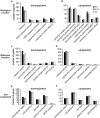Transcriptome analysis of microRNA156 overexpression alfalfa roots under drought stress
- PMID: 29921939
- PMCID: PMC6008443
- DOI: 10.1038/s41598-018-27088-8
Transcriptome analysis of microRNA156 overexpression alfalfa roots under drought stress
Abstract
Drought is one of the major abiotic stresses that negatively impact alfalfa growth and productivity. The role of microRNA156 (miR156) in drought has been demonstrated in plants. To date, there are no published studies investigating the role of miR156 in regulating global gene expression in alfalfa under drought. In our study, alfalfa genotypes overexpressing miR156 (miR156OE) exhibited reduced water loss, and enhanced root growth under drought. Our RNA-seq data showed that in response to drought, a total of 415 genes were upregulated and 169 genes were downregulated specifically in miR156OE genotypes. Genotypic comparison revealed that 285 genes were upregulated and 253 genes were downregulated in miR156OE genotypes relative to corresponding WT under drought. Gene Ontology enrichment analysis revealed that the number of differentially expressed genes belonging to biological process, molecular function and cell component functional groups was decreased in miR156OE genotypes under drought. Furthermore, RNA-Seq data showed downregulation of a gene encoding WD40 repeat in a miR156-specific manner. 5' RACE experiments verified cleavage of WD40-2 transcript under drought. Moreover, alfalfa plants overexpressing WD40-2 showed drought sensitive, whereas those with silenced WD40-2 exhibited drought tolerant phenotypes. These findings suggest that miR156 improves drought tolerance in alfalfa by targeting WD40-2.
Conflict of interest statement
The authors declare no competing interests.
Figures








References
-
- Boyer JS, et al. The U.S. drought of 2012 in perspective: A call to action. Global Food Security. 2013;2:139–143. doi: 10.1016/j.gfs.2013.08.002. - DOI
-
- Gourdji, S. M., Sibley, A. M. & Lobell, D. B. Global crop exposure to critical high temperatures in the reproductive period: Historical trends and future projections. Environ. Res. Lett. 8 (2013).
-
- Pryor SC, Barthelmie RJ, Schoof JT. High-resolution projections of climate-related risks for the Midwestern USA. Climate Res. 2013;56:61–79. doi: 10.3354/cr01143. - DOI
-
- Schindler DW. Lakes as sentinels and integrators for the effects of climate change on watersheds, airsheds, and landscapes. Limnol. Oceanogr. 2009;54:2349–2358. doi: 10.4319/lo.2009.54.6_part_2.2349. - DOI
Publication types
MeSH terms
Substances
LinkOut - more resources
Full Text Sources
Other Literature Sources

